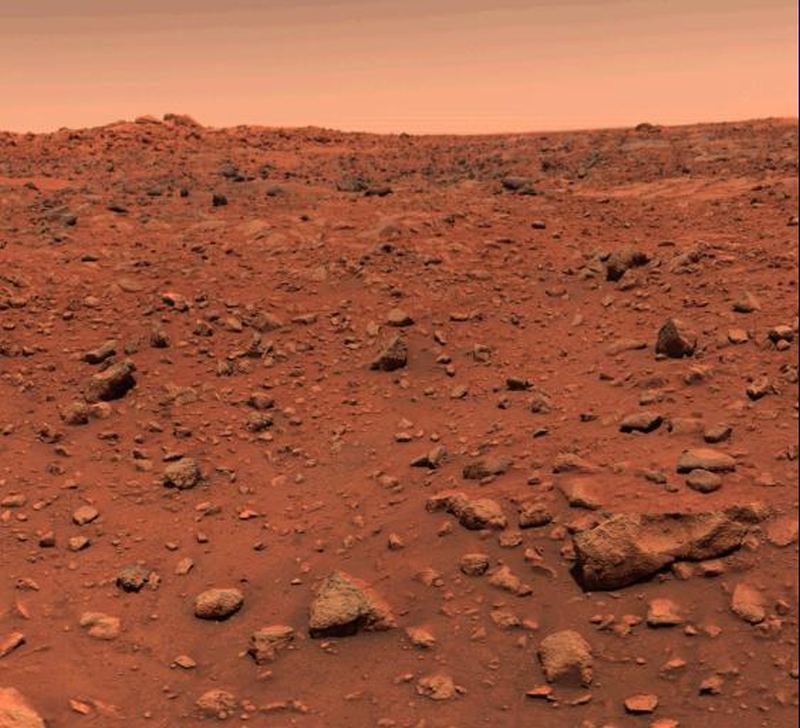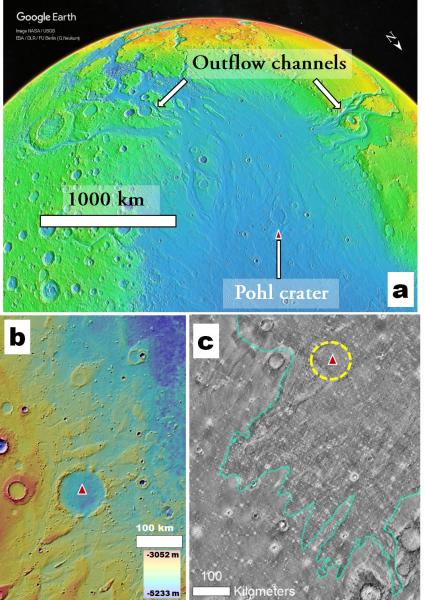Things were pretty wet back on Mars about three and a half billion years ago. You wouldn’t know that by looking at the planet today. But, would you believe a megatsunami happened there? It turns out that not one, but two of these rogue waves happened there some 3.4 billion years ago.
They occurred on the very spot where the Viking Lander settled down in 1976. Today, scientists know about these catastrophic floods, thanks to a re-examination of images of rock-strewn Chryse Planitia that Viking sent back.

Planetary Science Institute scientist Alexis Rodriguez studied the region in detail to figure out what happened to the region. It turns out that Viking’s landing spot contains deposits of material left by a pair of catastrophic floods. The second of these swept across the Martian landscape right after a three-kilometer-wide asteroid smacked into a Martian ocean. The fact that water once existed where Chryse Planitia is today isn’t a surprise. After all, that’s why Viking went there. But, figuring out how such a flood happened took a little detective work.
From orbital images available at the time, the Viking scientists selected the landing site because it looked like water once flowed there. “The lander was designed to seek evidence of extant life on the Martian surface, so to select a suitable landing site, the engineers and scientists at the time faced the arduous task of using some of the planet’s earliest acquired images, accompanied by Earth-based radar probing of the planet’s surface,” said Rodriguez, lead author of Evidence of an oceanic impact and megatsunami sedimentation in Chryse Planitia, Mars in Nature Scientific Reports. “In addition to meeting tight engineering constraints on the spacecraft’s orbital and descent paths, the landing site selection needed to fulfill a critical requirement—the presence of extensive evidence of former surface water.”
What Happened to Create a Megatsunami on Mars?
At first glance, Chryse Planitia looks dry, dusty, and rocky. But, it has all the hallmarks of rapidly flowing water. When water rushes across a landscape, it carries along rocks, sand, silt, and whatever else gets in the way. The same thing happened on Mars. Viking actually touched down on the lower edge of a flow feature called a fluvial channel. Chryse Planitia itself is a roughly circular plain north of the Martian equator. However, once Viking got on the ground, scientists noticed how boulder-strewn the region is. They decided that the area was a thick deposit either from multiple impacts or fractured lavas. The whole thing remained a mystery until Rodriguez started looking at the images and data again. His idea invokes more than one episode of catastrophic flooding.
In an earlier paper, he suggested that 3.4 billion years ago, there were two Martian megatsunamis. They smacked into the ancient ocean, sending huge waves across the Martian landscape. Between them, the ocean receded quite a bit and the climate became much colder. Rodriguez also identified a possible marine impact crater—Pohl crater—which likely generated the second of these two megatsunamis.
“Pohl is outstanding in several respects; it is atop immense fluvial landscapes formed by ocean-generating floods, and it is partly covered by the second megatsunami. Hence, we know that it must have formed after the ocean’s generation and before its disappearance,” said Anthony Lopez, a geosciences undergraduate student at Pima Community College and an intern working with Rodriguez.
A Map View of the Mars Megatsunami

(b) Close-up view showing the superposition of Pohl (red triangle) on outflow channel-excavated bedforms, indicating that its formation happened after the ocean-generating floods. Credit: MOLA Science Team/MSS/JPL/ NASA.
(c) Close-up view of Pohl showing that Pohl is covered by the younger of two previously proposed megatsunami deposits, indicating that the crater’s formation pre-dated the ocean’s disappearance. The blue line traces the front of the younger megatsunami deposit. Credit: Christensen et al. (2006).
Simulating and Mapping the Catastrophe
To get a better idea of what happened, Rodriguez and his team used a variety of mosaic images from Mars Reconnaissance Orbiter, Mars Odyssey, Mars Orbiter, and Mars Global Surveyor missions to produce detailed maps of the region. They mapped the distribution of water-related features within Chryse Planitia. Then, they searched for a relevant impact site—which turned out to be Pohl Crater. It wasn’t the first impact to smack into the region, but it created the fluvial plain the Viking lander studied. That second impact landed in the ocean. At that point, the ocean waters flowed catastrophically over the region. The flooding obliterated previous flow channels and created the deposits that Viking 1 landed on billions of years later.
The team also simulated the impact to understand the extent of its influence. “The simulated run-up extents of Pohl’s impact-generated megatsunami accurately reproduce the previously mapped margins of the older megatsunami, providing further robust support to the megatsunami – and hence ocean – hypothesis and this crater’s interpretation as its source,” said co-author Darrel Robertson of NASA’s Ames Research Center.
“The simulation clearly shows that the megatsunami was enormous, with an initial height of approximately 250 meters, and highly turbulent. Furthermore, our modeling also shows some radically different behavior of the megatsunami to what we are accustomed to imagining. Notably, the seismic shaking associated with the impact would have been so intense that it could have dislodged sea floor materials into the megatsunami, densifying some wave fronts into run-up debris flows.”
It appears that the megatsunami reached the Viking 1 lander site and could well have affected Pathfinder’s landing site, about 850 kilometers away. Ultimately, it may have helped create a new inland sea in the region.
Implications for Ancient Life?
While this study doesn’t prove anything about life on ancient Mars, it certainly reveals environments where it could have existed. “The ocean is thought to have been groundwater-fed from aquifers that likely formed much earlier in Martian history—over 3.7 billion years ago—when the planet was “Earth-like” with rivers, lakes, seas, and a primordial ocean,” said Rodriguez. “Consequently, the ocean’s habitability could have been inherited from that Earth-like Mars; the development of transient habitability is not sufficient; we need sustained continuity. So, the Viking 1 lander site was well suited to carry out the life detection experiment.”
With Viking and Pathfinder both in Chryse Planitia, it could well be that NASA’s probes have already sampled a couple of diverse marine environments on Mars. The next steps now are to see if Pohl could be a good landing site for further studies. Could it have been habitable? What will the geologic record tell us about the ancient ocean’s chemistry? Rodriguez says the science merits a second look, now that we know what happened there.
“Right after its formation, the crater would have generated submarine hydrothermal systems lasting tens of thousands of years, providing energy and nutrient-rich environments. As for specific targets, we find numerous possible mud volcanoes over areas of the second megatsunami covering and surrounding Pohl. Our observations suggest that these features extruded regionally megatsunami-retained seawater and marine sediments during extended geologic times. Sampling these materials would maximize the odds of directly probing the habitability of this Mars early ocean,” he said. “Our future characterizations will seek to identify a relatively small site offering access to the entire marine record. Such a terrain would merit a rover’s visit.”
For More Information
NASA May Have Landed on a Martian Megatsunami Deposit Nearly 50 Years Ago
Detection of Possible Mega-tsunami Deposits on Mars Revives Ancient Ocean Hypothesis

